PUBH6003: Health Systems and Economics - HIV/AIDS in India
VerifiedAdded on 2023/04/20
|7
|1409
|467
Report
AI Summary
This report examines the challenges and strategies for addressing the HIV/AIDS epidemic in India, considering the country's large population and the significant impact on vulnerable groups. It discusses the roles of various stakeholders, including healthcare providers, government agencies, and non-governmental organizations, in managing the disease, providing counseling, and raising awareness. The report also identifies obstacles to implementing a systems approach to HIV/AIDS prevention and control, such as funding limitations, the difficulty of reaching individuals in a large population, and socio-cultural factors. Furthermore, it suggests new governance strategies and the application of systems thinking to improve the effectiveness of HIV/AIDS programs in India, including sex education, increased parental involvement, and enhanced training for healthcare staff. The document emphasizes the need for innovative approaches to prevent further escalation of the disease among the Indian population. Desklib provides access to this and other solved assignments for students.
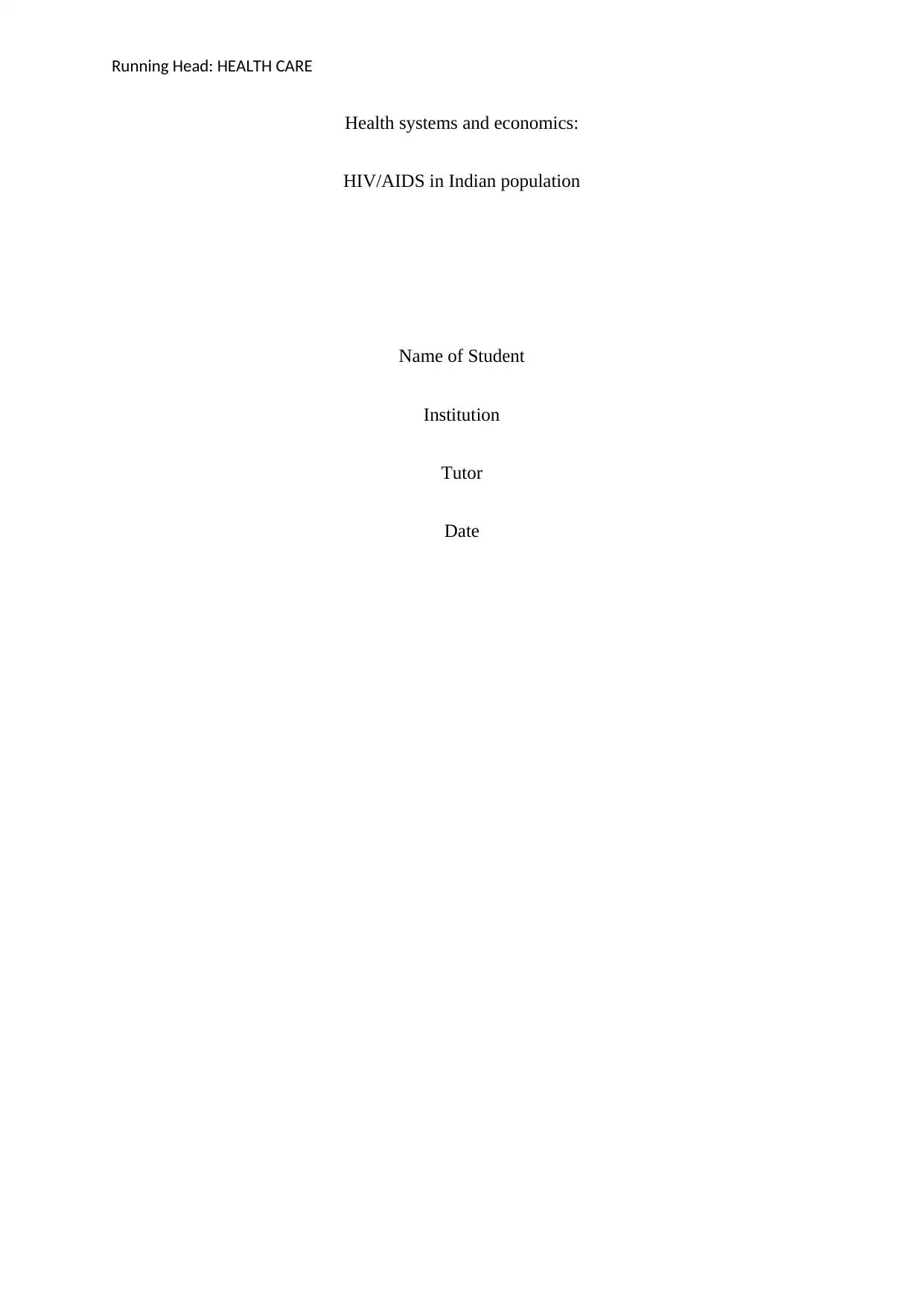
Running Head: HEALTH CARE
Health systems and economics:
HIV/AIDS in Indian population
Name of Student
Institution
Tutor
Date
Health systems and economics:
HIV/AIDS in Indian population
Name of Student
Institution
Tutor
Date
Paraphrase This Document
Need a fresh take? Get an instant paraphrase of this document with our AI Paraphraser
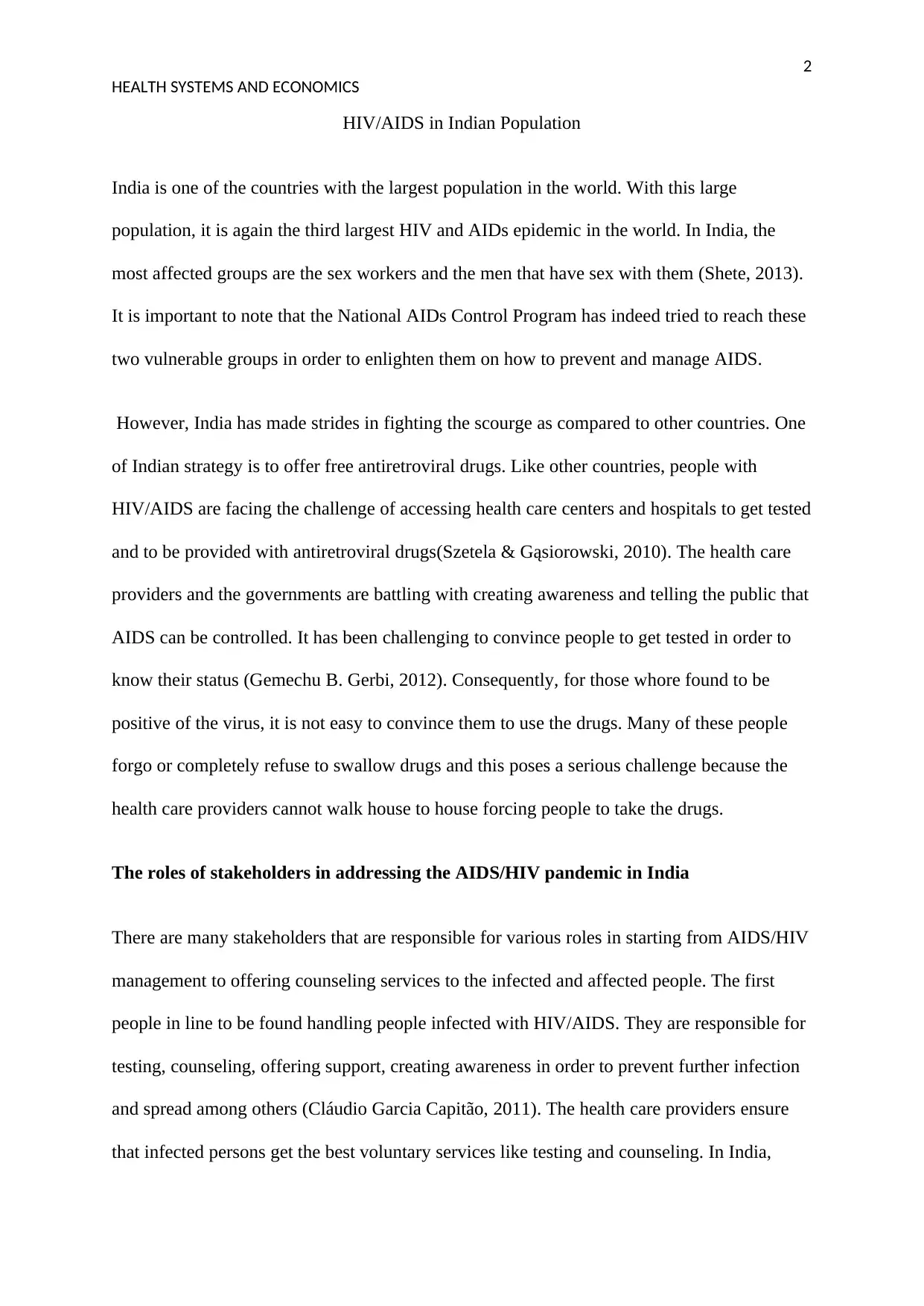
2
HEALTH SYSTEMS AND ECONOMICS
HIV/AIDS in Indian Population
India is one of the countries with the largest population in the world. With this large
population, it is again the third largest HIV and AIDs epidemic in the world. In India, the
most affected groups are the sex workers and the men that have sex with them (Shete, 2013).
It is important to note that the National AIDs Control Program has indeed tried to reach these
two vulnerable groups in order to enlighten them on how to prevent and manage AIDS.
However, India has made strides in fighting the scourge as compared to other countries. One
of Indian strategy is to offer free antiretroviral drugs. Like other countries, people with
HIV/AIDS are facing the challenge of accessing health care centers and hospitals to get tested
and to be provided with antiretroviral drugs(Szetela & Gąsiorowski, 2010). The health care
providers and the governments are battling with creating awareness and telling the public that
AIDS can be controlled. It has been challenging to convince people to get tested in order to
know their status (Gemechu B. Gerbi, 2012). Consequently, for those whore found to be
positive of the virus, it is not easy to convince them to use the drugs. Many of these people
forgo or completely refuse to swallow drugs and this poses a serious challenge because the
health care providers cannot walk house to house forcing people to take the drugs.
The roles of stakeholders in addressing the AIDS/HIV pandemic in India
There are many stakeholders that are responsible for various roles in starting from AIDS/HIV
management to offering counseling services to the infected and affected people. The first
people in line to be found handling people infected with HIV/AIDS. They are responsible for
testing, counseling, offering support, creating awareness in order to prevent further infection
and spread among others (Cláudio Garcia Capitão, 2011). The health care providers ensure
that infected persons get the best voluntary services like testing and counseling. In India,
HEALTH SYSTEMS AND ECONOMICS
HIV/AIDS in Indian Population
India is one of the countries with the largest population in the world. With this large
population, it is again the third largest HIV and AIDs epidemic in the world. In India, the
most affected groups are the sex workers and the men that have sex with them (Shete, 2013).
It is important to note that the National AIDs Control Program has indeed tried to reach these
two vulnerable groups in order to enlighten them on how to prevent and manage AIDS.
However, India has made strides in fighting the scourge as compared to other countries. One
of Indian strategy is to offer free antiretroviral drugs. Like other countries, people with
HIV/AIDS are facing the challenge of accessing health care centers and hospitals to get tested
and to be provided with antiretroviral drugs(Szetela & Gąsiorowski, 2010). The health care
providers and the governments are battling with creating awareness and telling the public that
AIDS can be controlled. It has been challenging to convince people to get tested in order to
know their status (Gemechu B. Gerbi, 2012). Consequently, for those whore found to be
positive of the virus, it is not easy to convince them to use the drugs. Many of these people
forgo or completely refuse to swallow drugs and this poses a serious challenge because the
health care providers cannot walk house to house forcing people to take the drugs.
The roles of stakeholders in addressing the AIDS/HIV pandemic in India
There are many stakeholders that are responsible for various roles in starting from AIDS/HIV
management to offering counseling services to the infected and affected people. The first
people in line to be found handling people infected with HIV/AIDS. They are responsible for
testing, counseling, offering support, creating awareness in order to prevent further infection
and spread among others (Cláudio Garcia Capitão, 2011). The health care providers ensure
that infected persons get the best voluntary services like testing and counseling. In India,
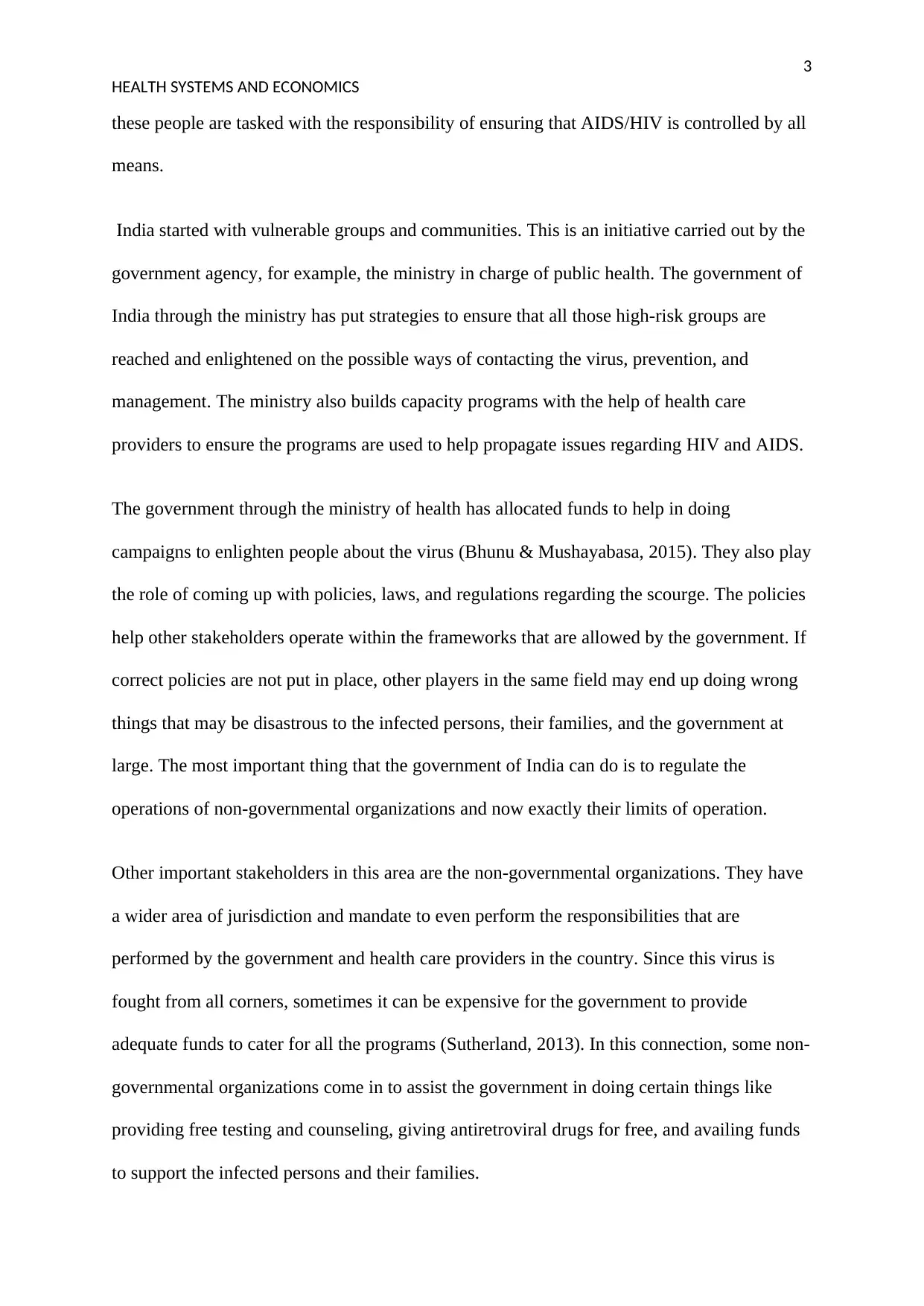
3
HEALTH SYSTEMS AND ECONOMICS
these people are tasked with the responsibility of ensuring that AIDS/HIV is controlled by all
means.
India started with vulnerable groups and communities. This is an initiative carried out by the
government agency, for example, the ministry in charge of public health. The government of
India through the ministry has put strategies to ensure that all those high-risk groups are
reached and enlightened on the possible ways of contacting the virus, prevention, and
management. The ministry also builds capacity programs with the help of health care
providers to ensure the programs are used to help propagate issues regarding HIV and AIDS.
The government through the ministry of health has allocated funds to help in doing
campaigns to enlighten people about the virus (Bhunu & Mushayabasa, 2015). They also play
the role of coming up with policies, laws, and regulations regarding the scourge. The policies
help other stakeholders operate within the frameworks that are allowed by the government. If
correct policies are not put in place, other players in the same field may end up doing wrong
things that may be disastrous to the infected persons, their families, and the government at
large. The most important thing that the government of India can do is to regulate the
operations of non-governmental organizations and now exactly their limits of operation.
Other important stakeholders in this area are the non-governmental organizations. They have
a wider area of jurisdiction and mandate to even perform the responsibilities that are
performed by the government and health care providers in the country. Since this virus is
fought from all corners, sometimes it can be expensive for the government to provide
adequate funds to cater for all the programs (Sutherland, 2013). In this connection, some non-
governmental organizations come in to assist the government in doing certain things like
providing free testing and counseling, giving antiretroviral drugs for free, and availing funds
to support the infected persons and their families.
HEALTH SYSTEMS AND ECONOMICS
these people are tasked with the responsibility of ensuring that AIDS/HIV is controlled by all
means.
India started with vulnerable groups and communities. This is an initiative carried out by the
government agency, for example, the ministry in charge of public health. The government of
India through the ministry has put strategies to ensure that all those high-risk groups are
reached and enlightened on the possible ways of contacting the virus, prevention, and
management. The ministry also builds capacity programs with the help of health care
providers to ensure the programs are used to help propagate issues regarding HIV and AIDS.
The government through the ministry of health has allocated funds to help in doing
campaigns to enlighten people about the virus (Bhunu & Mushayabasa, 2015). They also play
the role of coming up with policies, laws, and regulations regarding the scourge. The policies
help other stakeholders operate within the frameworks that are allowed by the government. If
correct policies are not put in place, other players in the same field may end up doing wrong
things that may be disastrous to the infected persons, their families, and the government at
large. The most important thing that the government of India can do is to regulate the
operations of non-governmental organizations and now exactly their limits of operation.
Other important stakeholders in this area are the non-governmental organizations. They have
a wider area of jurisdiction and mandate to even perform the responsibilities that are
performed by the government and health care providers in the country. Since this virus is
fought from all corners, sometimes it can be expensive for the government to provide
adequate funds to cater for all the programs (Sutherland, 2013). In this connection, some non-
governmental organizations come in to assist the government in doing certain things like
providing free testing and counseling, giving antiretroviral drugs for free, and availing funds
to support the infected persons and their families.
⊘ This is a preview!⊘
Do you want full access?
Subscribe today to unlock all pages.

Trusted by 1+ million students worldwide
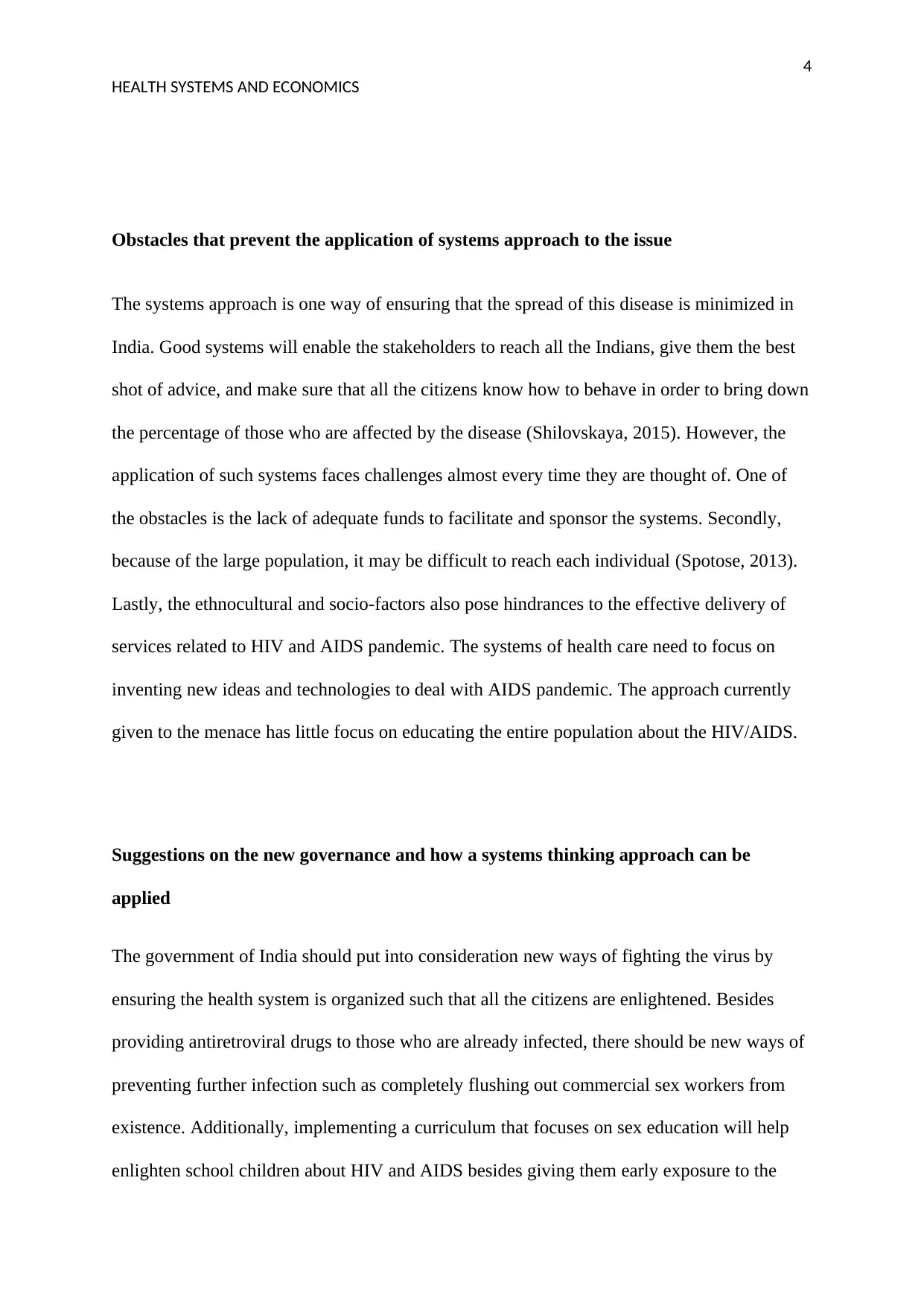
4
HEALTH SYSTEMS AND ECONOMICS
Obstacles that prevent the application of systems approach to the issue
The systems approach is one way of ensuring that the spread of this disease is minimized in
India. Good systems will enable the stakeholders to reach all the Indians, give them the best
shot of advice, and make sure that all the citizens know how to behave in order to bring down
the percentage of those who are affected by the disease (Shilovskaya, 2015). However, the
application of such systems faces challenges almost every time they are thought of. One of
the obstacles is the lack of adequate funds to facilitate and sponsor the systems. Secondly,
because of the large population, it may be difficult to reach each individual (Spotose, 2013).
Lastly, the ethnocultural and socio-factors also pose hindrances to the effective delivery of
services related to HIV and AIDS pandemic. The systems of health care need to focus on
inventing new ideas and technologies to deal with AIDS pandemic. The approach currently
given to the menace has little focus on educating the entire population about the HIV/AIDS.
Suggestions on the new governance and how a systems thinking approach can be
applied
The government of India should put into consideration new ways of fighting the virus by
ensuring the health system is organized such that all the citizens are enlightened. Besides
providing antiretroviral drugs to those who are already infected, there should be new ways of
preventing further infection such as completely flushing out commercial sex workers from
existence. Additionally, implementing a curriculum that focuses on sex education will help
enlighten school children about HIV and AIDS besides giving them early exposure to the
HEALTH SYSTEMS AND ECONOMICS
Obstacles that prevent the application of systems approach to the issue
The systems approach is one way of ensuring that the spread of this disease is minimized in
India. Good systems will enable the stakeholders to reach all the Indians, give them the best
shot of advice, and make sure that all the citizens know how to behave in order to bring down
the percentage of those who are affected by the disease (Shilovskaya, 2015). However, the
application of such systems faces challenges almost every time they are thought of. One of
the obstacles is the lack of adequate funds to facilitate and sponsor the systems. Secondly,
because of the large population, it may be difficult to reach each individual (Spotose, 2013).
Lastly, the ethnocultural and socio-factors also pose hindrances to the effective delivery of
services related to HIV and AIDS pandemic. The systems of health care need to focus on
inventing new ideas and technologies to deal with AIDS pandemic. The approach currently
given to the menace has little focus on educating the entire population about the HIV/AIDS.
Suggestions on the new governance and how a systems thinking approach can be
applied
The government of India should put into consideration new ways of fighting the virus by
ensuring the health system is organized such that all the citizens are enlightened. Besides
providing antiretroviral drugs to those who are already infected, there should be new ways of
preventing further infection such as completely flushing out commercial sex workers from
existence. Additionally, implementing a curriculum that focuses on sex education will help
enlighten school children about HIV and AIDS besides giving them early exposure to the
Paraphrase This Document
Need a fresh take? Get an instant paraphrase of this document with our AI Paraphraser
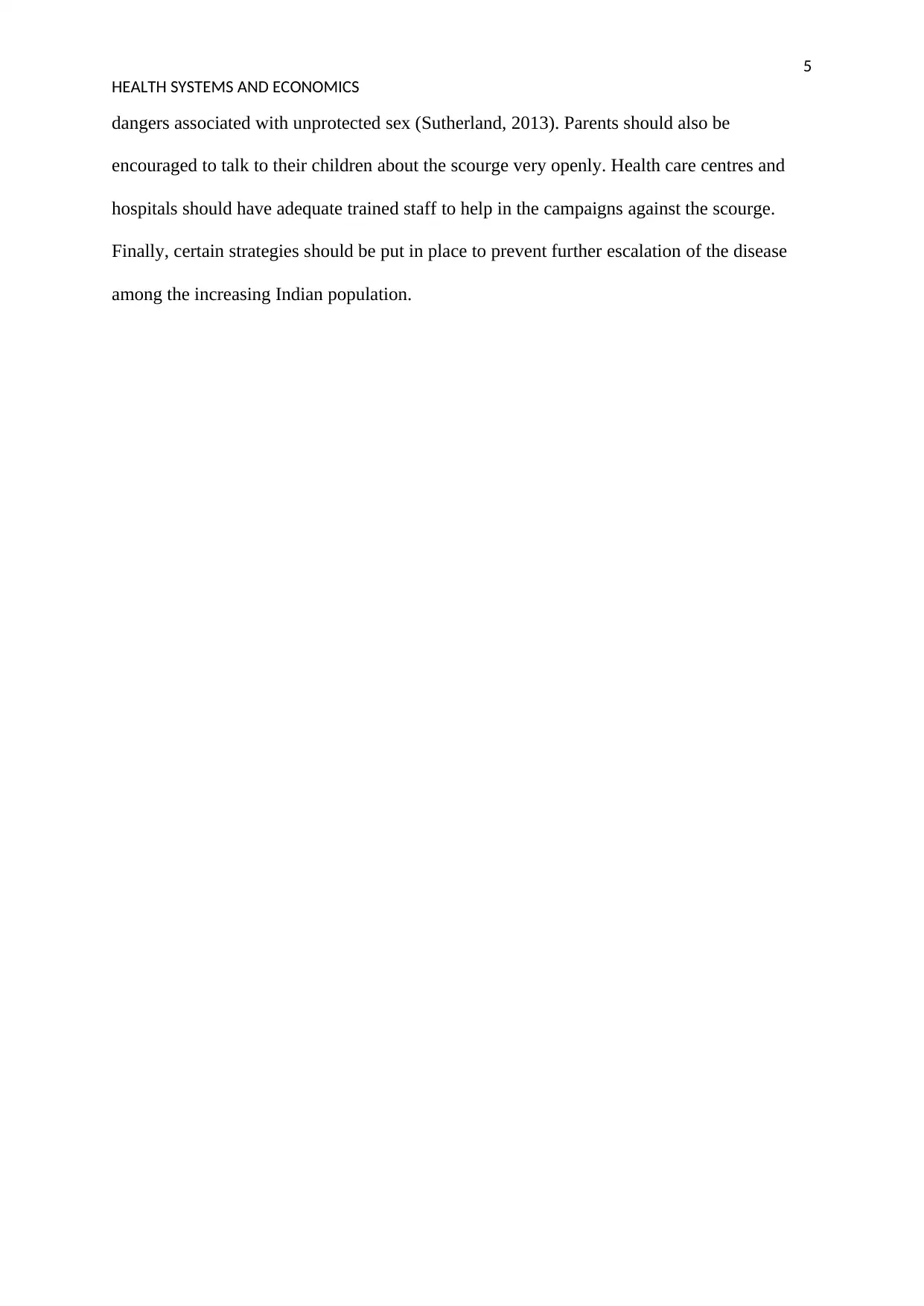
5
HEALTH SYSTEMS AND ECONOMICS
dangers associated with unprotected sex (Sutherland, 2013). Parents should also be
encouraged to talk to their children about the scourge very openly. Health care centres and
hospitals should have adequate trained staff to help in the campaigns against the scourge.
Finally, certain strategies should be put in place to prevent further escalation of the disease
among the increasing Indian population.
HEALTH SYSTEMS AND ECONOMICS
dangers associated with unprotected sex (Sutherland, 2013). Parents should also be
encouraged to talk to their children about the scourge very openly. Health care centres and
hospitals should have adequate trained staff to help in the campaigns against the scourge.
Finally, certain strategies should be put in place to prevent further escalation of the disease
among the increasing Indian population.
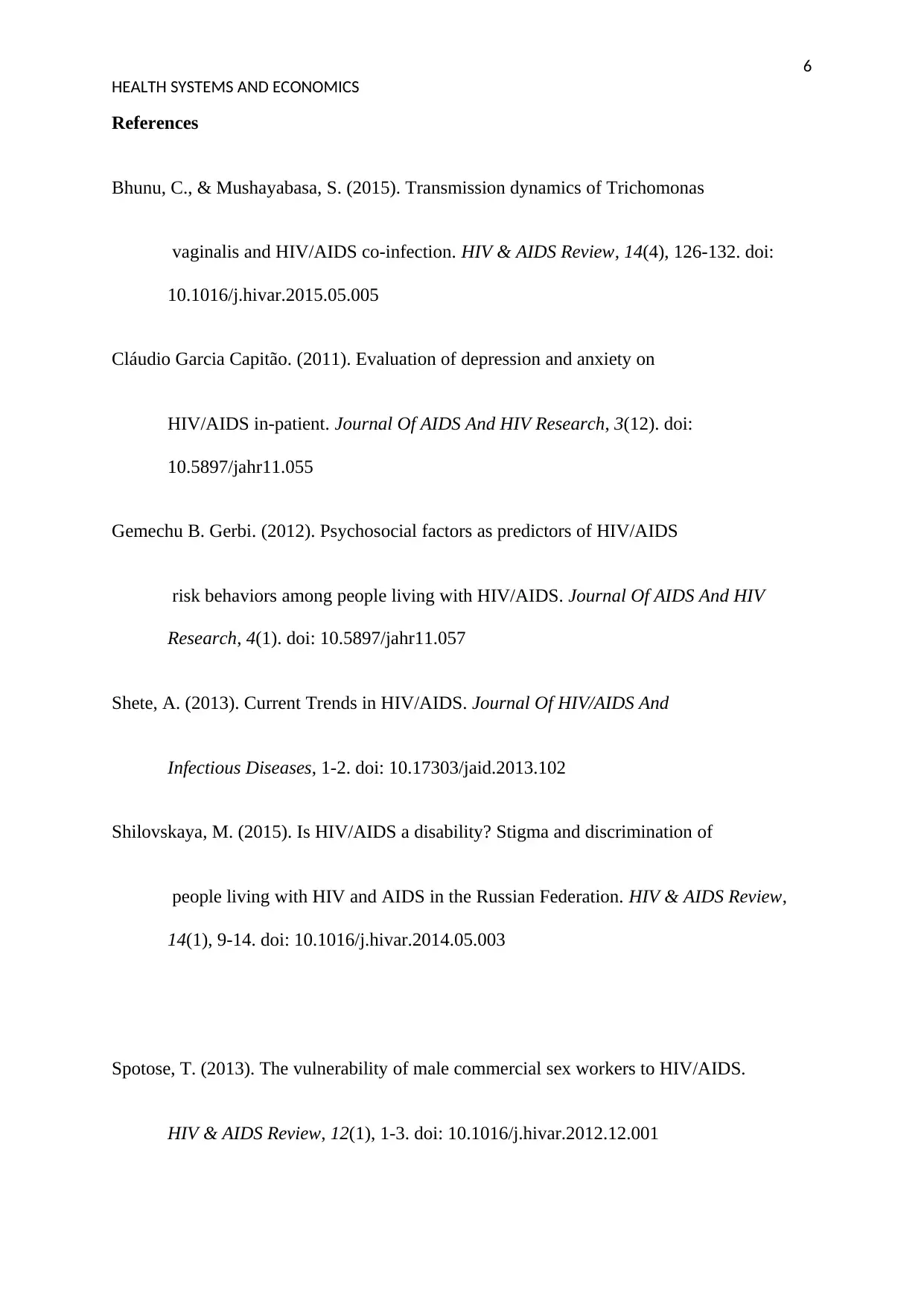
6
HEALTH SYSTEMS AND ECONOMICS
References
Bhunu, C., & Mushayabasa, S. (2015). Transmission dynamics of Trichomonas
vaginalis and HIV/AIDS co-infection. HIV & AIDS Review, 14(4), 126-132. doi:
10.1016/j.hivar.2015.05.005
Cláudio Garcia Capitão. (2011). Evaluation of depression and anxiety on
HIV/AIDS in-patient. Journal Of AIDS And HIV Research, 3(12). doi:
10.5897/jahr11.055
Gemechu B. Gerbi. (2012). Psychosocial factors as predictors of HIV/AIDS
risk behaviors among people living with HIV/AIDS. Journal Of AIDS And HIV
Research, 4(1). doi: 10.5897/jahr11.057
Shete, A. (2013). Current Trends in HIV/AIDS. Journal Of HIV/AIDS And
Infectious Diseases, 1-2. doi: 10.17303/jaid.2013.102
Shilovskaya, M. (2015). Is HIV/AIDS a disability? Stigma and discrimination of
people living with HIV and AIDS in the Russian Federation. HIV & AIDS Review,
14(1), 9-14. doi: 10.1016/j.hivar.2014.05.003
Spotose, T. (2013). The vulnerability of male commercial sex workers to HIV/AIDS.
HIV & AIDS Review, 12(1), 1-3. doi: 10.1016/j.hivar.2012.12.001
HEALTH SYSTEMS AND ECONOMICS
References
Bhunu, C., & Mushayabasa, S. (2015). Transmission dynamics of Trichomonas
vaginalis and HIV/AIDS co-infection. HIV & AIDS Review, 14(4), 126-132. doi:
10.1016/j.hivar.2015.05.005
Cláudio Garcia Capitão. (2011). Evaluation of depression and anxiety on
HIV/AIDS in-patient. Journal Of AIDS And HIV Research, 3(12). doi:
10.5897/jahr11.055
Gemechu B. Gerbi. (2012). Psychosocial factors as predictors of HIV/AIDS
risk behaviors among people living with HIV/AIDS. Journal Of AIDS And HIV
Research, 4(1). doi: 10.5897/jahr11.057
Shete, A. (2013). Current Trends in HIV/AIDS. Journal Of HIV/AIDS And
Infectious Diseases, 1-2. doi: 10.17303/jaid.2013.102
Shilovskaya, M. (2015). Is HIV/AIDS a disability? Stigma and discrimination of
people living with HIV and AIDS in the Russian Federation. HIV & AIDS Review,
14(1), 9-14. doi: 10.1016/j.hivar.2014.05.003
Spotose, T. (2013). The vulnerability of male commercial sex workers to HIV/AIDS.
HIV & AIDS Review, 12(1), 1-3. doi: 10.1016/j.hivar.2012.12.001
⊘ This is a preview!⊘
Do you want full access?
Subscribe today to unlock all pages.

Trusted by 1+ million students worldwide
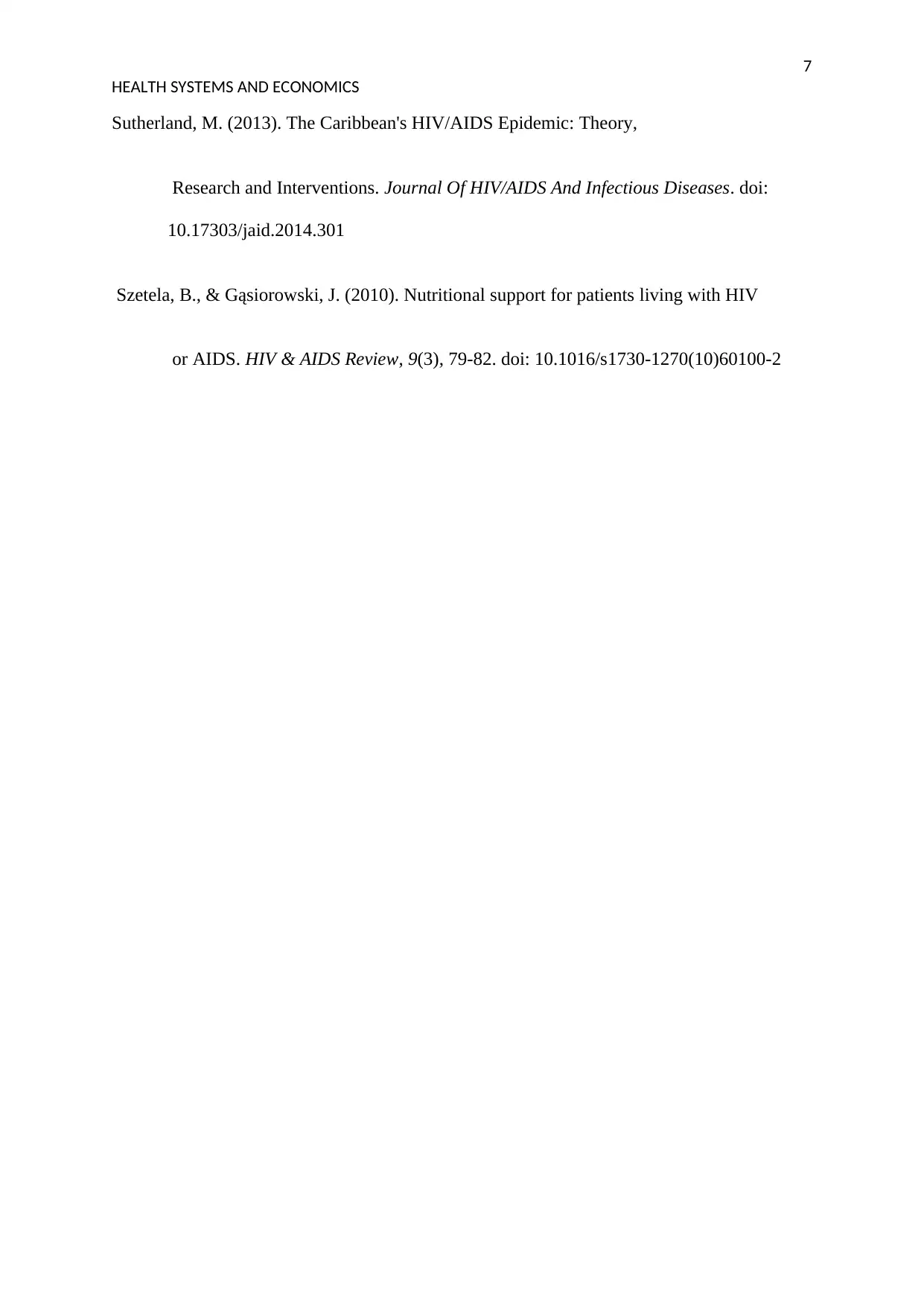
7
HEALTH SYSTEMS AND ECONOMICS
Sutherland, M. (2013). The Caribbean's HIV/AIDS Epidemic: Theory,
Research and Interventions. Journal Of HIV/AIDS And Infectious Diseases. doi:
10.17303/jaid.2014.301
Szetela, B., & Gąsiorowski, J. (2010). Nutritional support for patients living with HIV
or AIDS. HIV & AIDS Review, 9(3), 79-82. doi: 10.1016/s1730-1270(10)60100-2
HEALTH SYSTEMS AND ECONOMICS
Sutherland, M. (2013). The Caribbean's HIV/AIDS Epidemic: Theory,
Research and Interventions. Journal Of HIV/AIDS And Infectious Diseases. doi:
10.17303/jaid.2014.301
Szetela, B., & Gąsiorowski, J. (2010). Nutritional support for patients living with HIV
or AIDS. HIV & AIDS Review, 9(3), 79-82. doi: 10.1016/s1730-1270(10)60100-2
1 out of 7
Related Documents
Your All-in-One AI-Powered Toolkit for Academic Success.
+13062052269
info@desklib.com
Available 24*7 on WhatsApp / Email
![[object Object]](/_next/static/media/star-bottom.7253800d.svg)
Unlock your academic potential
Copyright © 2020–2025 A2Z Services. All Rights Reserved. Developed and managed by ZUCOL.





